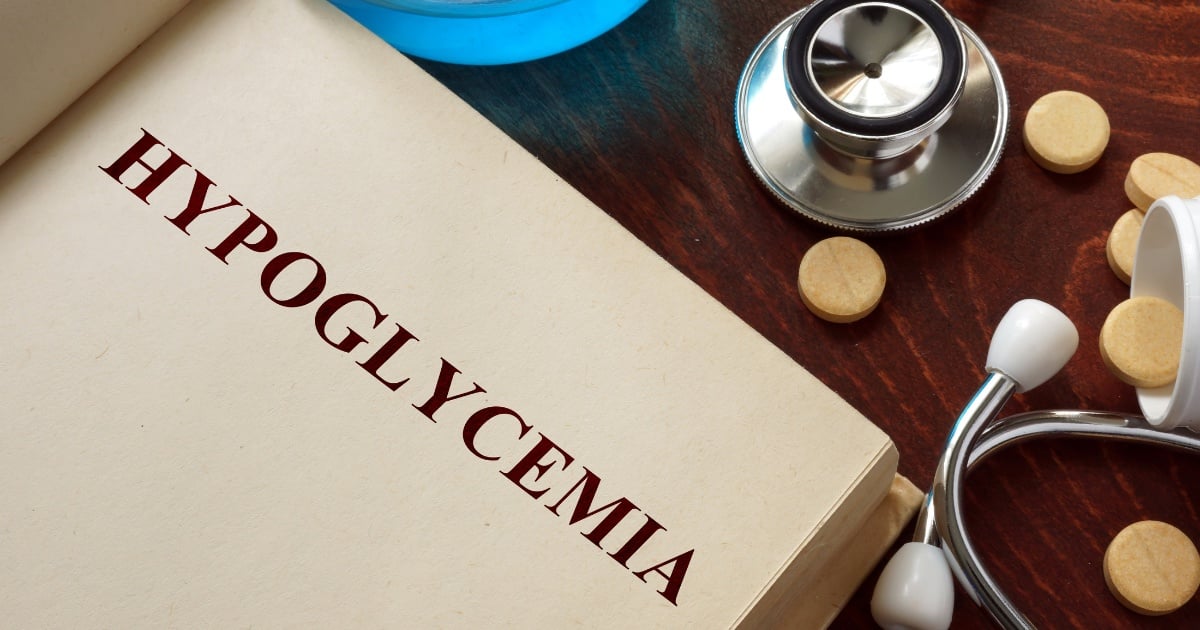For anyone who lives with diabetes, the possibility of hypoglycemia, or low blood glucose (sugar) levels, can be a constant concern. An extra layer of complexity is added when people with diabetes can’t detect that their blood sugars are dropping, a condition known as hypoglycemia unawareness.
It is both more common — and potentially more dangerous — than many people think.
This article will explain what you need to know about hypoglycemia unawareness, how to treat it, and steps you can take to help prevent it.

Table of Contents
- What is hypoglycemia?
- What are the symptoms of hypoglycemia?
- What is hypoglycemia unawareness?
- What are the risk factors for hypoglycemia unawareness?
- What causes hypoglycemia unawareness?
- Can medications cause hypoglycemia unawareness?
- Are there complications from hypoglycemia unawareness?
- How can you prevent and treat hypoglycemia unawareness?
- Tips for preventing low blood sugars
- Final thoughts
What is hypoglycemia?
Hypoglycemia, commonly referred to as low blood sugar, occurs when the concentration of glucose in the bloodstream falls below normal levels. This is often a result of an imbalance between factors that raise blood glucose, such as food intake, and those that lower it, such as insulin or other glucose-lowering medications.
While everyone with diabetes sometimes experiences low blood sugar levels, people who use insulin generally experience episodes of hypoglycemia more frequently.
What is considered low blood sugar will vary by the person based on health history, health goals, and what blood sugar levels you and your health care provider determine is best for your target range.
The U.S. Centers for Disease Control and Prevention (CDC) describes low blood sugar levels as anything under 70 mg/dL (3.9 mmol/L) in people with diabetes.
Severely low blood glucose levels are considered to be anything under 54 mg/dL (3.0 mmol/L). This will require immediate treatment with either fast-acting glucose or glucagon (if the person cannot chew or swallow).
Learn more about hypoglycemia in: Symptoms of Low Blood Sugar (Hypoglycemia).
What are the symptoms of hypoglycemia?
Common symptoms of hypoglycemia include:
- Shakiness
- Dizziness
- Fatigue/lethargy
- Sadness
- Confusion
- Sweating
- Rapid heart rate
- Nervousness
- Hunger
- Trouble concentrating
- Irritability
Symptoms of severe low blood sugar include:
- Slurred speech
- Confused thinking
- Loss of consciousness
- Seizures
- Coma
- In rare instances, death
If a person is unable to chew and/or swallow, glucagon administration is unavailable or ineffective, promptly call 911.When severely low blood sugar is left untreated, it can be fatal.
Read more about hypoglycemia symptoms in: Symptoms of Low Blood Sugar (Hypoglycemia).
What is hypoglycemia unawareness?
Hypoglycemia unawareness is a condition in which someone does not get the usual physical warning signs their blood sugar levels are going low.
It is much more common than many people think and is estimated to affect about 40 percent of people with type 1 diabetes. It also affects 10 to 15 percent of people with type 2 diabetes who use insulin or a class of medicines known as sulfonylureas, both of which can cause low blood sugar.
Taking insulin increases the risk of experiencing low blood sugar levels, and frequent low blood sugar levels increase the risk of developing hypoglycemia unawareness.
Hypoglycemia unawareness significantly increases the risk associated with low blood sugar episodes by impairing a person’s ability to recognize and respond to the early warning signs of hypoglycemia.
Due to the lack of awareness, this can lead to hypoglycemia becoming severe. Without fast treatment, it has the potential to result in acute complications such as loss of consciousness, seizures, and in extreme cases, life-threatening outcomes.
Additionally, recurring episodes of severe hypoglycemia can contribute to long-term complications, such as cardiovascular and cognitive issues.
The risk and incidence of experiencing severely low blood sugar levels increase dramatically for people who have hypoglycemia unawareness.
What are the risk factors for hypoglycemia unawareness?
There are several known risk factors for developing hypoglycemia unawareness, including the following:
- Long-term use of insulin. Research indicates that the risk of developing hypoglycemia unawareness increases with the duration of insulin treatment. For example, in one study, about half of the people who had used insulin for over 20 years developed hypoglycemia unawareness, whereas only about 20 percent of those who had been on insulin for fewer than 10 years experienced it.
- A history of recent and/or recurrent low blood sugar events (such as lows at night, when you may not be able to detect or treat the low).
- Advanced age.
What causes hypoglycemia unawareness?
The exact causes of hypoglycemia unawareness are not entirely understood. However, several key factors are thought to contribute to its development:
- Frequent episodes of hypoglycemia can lead to a condition known as hypoglycemia-associated autonomic failure (HAAF), where the body’s normal alert system to low blood sugar becomes less sensitive. Essentially, the body and brain start to adapt to lower glucose levels, diminishing the perception of hypoglycemic symptoms.
- Tight blood sugar control, while crucial for managing diabetes and preventing long-term complications, can paradoxically increase the risk of hypoglycemia unawareness. This is because aiming for lower blood sugar targets may lead to more frequent episodes of hypoglycemia, thereby increasing the likelihood of HAAF.
Not everyone who takes insulin will experience hypoglycemia unawareness, but the likelihood increases with the length of time someone has had diabetes. Those who have lived with diabetes for an extended period, and especially those who consistently aim for very tight blood sugar control, are at an increased risk of developing this condition.
Can medications cause hypoglycemia unawareness?
Certain medications, including beta-blockers, can mask the symptoms of hypoglycemia, such as heart palpitations and tremors, making it harder to detect an oncoming low. This is because they block the action of adrenaline.
Although these medications treat conditions like angina (a type of chest pain), heart failure, and high blood pressure, this effect on adrenaline can make it more difficult to detect the early signs of hypoglycemia.
Selective serotonin reuptake inhibitors (SSRIs), used to treat depression, may also mask low symptoms, although their impact is less clear.
Additionally, alcohol can interfere with blood sugar regulation and mask symptoms of lows. And this substance can be doubly problematic because it can also increase your likelihood of going low.
Are there complications from hypoglycemia unawareness?
Having hypoglycemia unawareness significantly increases the risk of both short- and long-term complications.
Without the typical early warning signs of low blood sugar, the situation is more likely to be severe by the time it is recognized and treatment is attempted. These severe lows can impair critical functions, making it difficult to perform everyday activities such as driving, reading, and working, and can cloud judgment and cognition.
If you don’t treat your low blood sugar quickly enough, it may even result in more serious complications, such as loss of consciousness, seizures, coma, and brain injury. Over time, recurring severe hypoglycemia can also contribute to cardiovascular complications and cognitive decline.
How can you prevent and treat hypoglycemia unawareness?
Talk to your healthcare provider if you notice that you are no longer detecting symptoms of low blood sugar.
Most people with diabetes should be able to feel low blood sugar levels when they reach 70 mg/dL (3.9 mmol/L), although this level can vary for people with a history of frequent lows.
If a person with diabetes has hypoglycemia unawareness, formal programs exist to improve blood glucose awareness. Additionally, your health care provider can discuss potential ways to become more sensitive to your blood sugar levels falling.
Your healthcare provider may suggest lowering your daily insulin dosage, slightly increasing your target blood sugar range, or modifying your physical activity routine to prevent low blood sugar levels in the first place.
You may also be able to catch low blood sugars sooner by checking your blood sugar levels more frequently or wearing a continuous glucose monitor (CGM). Carrying fast-acting carbohydrates with you to immediately treat lows is also recommended, as is having a glucagon kit on hand in the event of a severe low (glucagon is a hormone that helps raise glucose levels).
For some, a diabetes alert dog (DAD) may provide an additional layer of security by alerting to low blood sugars. However, this option requires consideration of the training and commitment involved.
Additionally, some people have found that switching to slower-acting insulins can be helpful if they experience persistent hypoglycemia unawareness. These insulins have a slower release time, providing a more predictable blood-sugar-lowering effect, and so may help prevent severe lows.
For those who have access to the technology, using an automated insulin delivery (AID) system can significantly help in preventing hypoglycemia.
These systems use values from your CGM and run them through an algorithm to determine how much insulin to deliver via a pump. Insulin is reduced or paused as blood sugar levels decrease, helping to prevent hypoglycemia.
In the United States, several AID systems are available, including the Medtronic MiniMed 770G System, Medtronic MiniMed 780G System, Tandem Diabetes Care t:slim X2 with Control-IQ Technology, and Omnipod 5 Automated Insulin Delivery System.
You may not always be able to reverse hypoglycemia unawareness, but you can increase your sensitivity, mostly by avoiding low blood sugar levels for a while.
Work closely with your doctor to tailor these approaches to your specific needs and circumstances.
Tips for preventing low blood sugars
While you cannot prevent low blood sugar in all cases, you can minimize how often you experience them with the following strategies:
- See your doctor or endocrinologist regularly for medication adjustments.
- Consider using a food scale for more precise carbohydrate counting.
- Eat meals and snacks on a schedule.
- Avoid exercise with a blood sugar under 100 mg/dL (5.6 mmol/L) or when you’ve recently taken insulin to reduce the risk of exercise-induced hypoglycemia.
- Avoid going to sleep with a blood sugar under 100 mg/dL (5.6 mmol/L) to reduce the risk of overnight hypoglycemia.
- Take all insulin and other medications as prescribed.
- If you dose for a certain number of carbohydrates, make sure you eat all the carbohydrates that you’ve dosed for.
- Drink alcohol in moderation, if at all.
- Avoid drinking alcohol with a blood sugar under 100 mg/dL (5.6 mmol/L).
- Always carry fast-acting glucose with you to treat lows.
- Consider wearing a CGM.
- Set your CGM low and predictive low alerts to “on.”
- Treat low blood sugars early, before they become potentially dangerous.
Final thoughts
Managing hypoglycemia unawareness requires a variety of strategies. Regular monitoring of blood glucose levels, especially with the help of a CGM device, plays an important role in early detection and management of low blood sugar episodes.
Adjusting insulin doses and treatment plans in consultation with healthcare professionals can also help lessen the risks associated with hypoglycemia unawareness.
Lifestyle modifications, including meal planning, careful monitoring of physical activity, and responsible alcohol consumption, are additionally important for managing blood glucose levels and avoiding lows. In some cases, the support of a diabetes alert dog can provide an additional layer of safety by detecting low blood sugars even when you cannot.
If you’re experiencing hypoglycemia unawareness, it’s important to speak with your healthcare provider to explore strategies tailored to your specific needs. With the right combination of medical feedback, self-care, and support tools, it’s possible to manage this condition effectively and reduce the risk of serious complications.





Gina
How do I adjust my Lantus insulin that I divide in half so I don’t get lows 6 hours later while sleeping? Example 8 units am and pm 11-12 hours apart.
Thank you!
Christel Oerum, MS
You have to work with your medical team on adjusting your insulin doses. Your endocrinologist might start by dividing the total dose equally between your morning and your evening dose, and then have you adjust if needed. It might also be worth experimenting with when you take your dose, maybe taking it a little later at night
Cheryl Stebbins
I have had Type 1 diabetes for over 60 years. Have gone thru insulin shots, pens, & 5 different pumps. I have had hypo unawareness for many years. My current pump is the Tandem X2 and it communicates with my Dexcom G7 GCM. I watch & listen to my pump all the time, and thank God for the advances the X2 has. I do still have lows & highs, and I do always have carbs or glucose on hand. Your article is awesome! If anyone out there does not read it carefully & follow your suggestions, they are risking their lives. My Endocrinologist is also a Type 1 diabetic. I follow his advice & pump adjustments closely. I have had breast cancer (chemo & radiation), 2 broken hips, 1 broken knee, & 2 broken elbows over the years. Surgeries are always a challenge, especially for diabetics. I have a lot of stories!